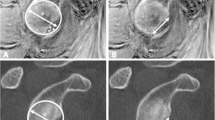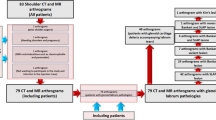Abstract
Objectives
To evaluate the potential of susceptibility-weighted-magnetic-resonance-imaging (SWMR) for the detection of sub-coracoacromial spurs in patients with clinically suspected subacromial impingement syndrome (SAIS), compared to standard MR-sequences and radiographs.
Methods
Forty-four patients with suspected SAIS were included. All patients underwent radiography, standard MRI of the shoulder and SWMR. Radiograph-based identification of sub-coracoacromial spurs served as goldstandard. Radiographs identified twenty-three spurs in twenty-three patients. Twenty-one patients without spur formation served as reference group. Detection rate, sensitivity/specificity and interobserver-agreements were calculated. Linear regression was applied to determine the relationship between size measurements on radiographs and MRI.
Results
Detection rates for spurs on standard MRI and SWMR were 47.8 % and 91.3 % compared to radiography (p<0.001). SWMR demonstrated a sensitivity of 97.7 % (CI=0.92-1) and a specificity of 91.3 % (CI=0.788-1) for the identification of spurs. Standard MR-sequences achieved a sensitivity of 47.8 % (CI=0.185-0.775) and a specificity of 80.8 % (CI=0.642-0.978). Size measurements between SWMR and radiography showed a good correlation (R2=0.75;p<0.0001), while overestimating lesion size (5.7±1.2 mm; 4.3±1.3 mm;p<0.0001). Interobserver-agreement for spurs was high on SWMR (R2=0.74;p<0.0001), but low on standard MRI (R2=0.24;p<0.0001).
Conclusions
SWMR allows a reliable detection of sub-coracoacromial spur formation in patients with SAIS and is superior to standard MR-sequences using radiography as goldstandard.
Key Points
• SWMR has the potential to reliably identify sub-coracoacromial spurs without radiation exposure.
• SWMR provides comparable detection rates to conventional radiography for sub-coracoacromial spur formation.
• SWMR yields higher detection rates compared to standard-MR regarding sub-coracoacromial spur formation.
• SWMR can be implemented in routine shoulder MRI protocols.




Similar content being viewed by others
References
Paloneva J, Koskela S, Kautiainen H, Vanhala M, Kiviranta I (2013) Consumption of medical resources and outcome of shoulder disorders in primary health care consulters. BMC Musculoskelet Disord 14:348
Greving K, Dorrestijn O, Winters JC et al (2012) Incidence, prevalence, and consultation rates of shoulder complaints in general practice. Scand J Rheumatol 41:150–155
Millar AL, Lasheway PA, Eaton W, Christensen F (2006) A retrospective, descriptive study of shoulder outcomes in outpatient physical therapy. J Orthop Sports Phys Ther 36:403–414
Bot SD, van der Waal JM, Terwee CB et al (2005) Incidence and prevalence of complaints of the neck and upper extremity in general practice. Ann Rheum Dis 64:118–123
Neer CS 2nd (1972) Anterior acromioplasty for the chronic impingement syndrome in the shoulder: a preliminary report. J Bone Joint Surg Am 54:41–50
Codman EA, Akerson IB (1931) The Pathology Associated with Rupture of the Supraspinatus Tendon. Ann Surg 93:348–359
Ozaki J, Fujimoto S, Nakagawa Y, Masuhara K, Tamai S (1988) Tears of the rotator cuff of the shoulder associated with pathological changes in the acromion. A study in cadavera. J Bone Joint Surg Am 70:1224–1230
Bjornsson H, Norlin R, Knutsson A, Adolfsson L (2010) Fewer rotator cuff tears fifteen years after arthroscopic subacromial decompression. J Shoulder Elbow Surg 19:111–115
Tuite MJ (2012) Magnetic resonance imaging of rotator cuff disease and external impingement. Magn Reson Imaging Clin N Am 20:187–200
Cummins CA, Sasso LM, Nicholson D (2009) Impingement syndrome: temporal outcomes of nonoperative treatment. J Shoulder Elbow Surg 18:172–177
Chaudhury S, Gwilym SE, Moser J, Carr AJ (2010) Surgical options for patients with shoulder pain. Nat Rev Rheumatol 6:217–226
Alkhader M, Ohbayashi N, Tetsumura A et al (2010) Diagnostic performance of magnetic resonance imaging for detecting osseous abnormalities of the temporomandibular joint and its correlation with cone beam computed tomography. Dentomaxillofac Radiol 39:270–276
Haacke EM, Xu Y, Cheng YC, Reichenbach JR (2004) Susceptibility weighted imaging (SWI). Magn Reson Med 52:612–618
Haacke EM, Mittal S, Wu Z, Neelavalli J, Cheng YC (2009) Susceptibility-weighted imaging: technical aspects and clinical applications, part 1. AJNR Am J Neuroradiol 30:19–30
Zhu WZ, Qi JP, Zhan CJ et al (2008) Magnetic resonance susceptibility weighted imaging in detecting intracranial calcification and hemorrhage. Chin Med J (Engl) 121:2021–2025
Wisnieff C, Ramanan S, Olesik J, Gauthier S, Wang Y, Pitt D (2014) Quantitative susceptibility mapping (QSM) of white matter multiple sclerosis lesions: Interpreting positive susceptibility and the presence of iron. Magn Reson Med. doi:10.1002/mrm.25420
Wang Y, Liu T (2014) Quantitative susceptibility mapping (QSM): Decoding MRI data for a tissue magnetic biomarker. Magn Reson Med. doi:10.1002/mrm.25358
Bai Y, Wang MY, Han YH et al (2013) Susceptibility weighted imaging: a new tool in the diagnosis of prostate cancer and detection of prostatic calcification. PLoS One 8, e53237
Mittal S, Wu Z, Neelavalli J, Haacke EM (2009) Susceptibility-weighted imaging: technical aspects and clinical applications, part 2. AJNR Am J Neuroradiol 30:232–252
Chen W, Zhu W, Kovanlikaya I et al (2014) Intracranial calcifications and hemorrhages: characterization with quantitative susceptibility mapping. Radiology 270:496–505
Zulfiqar M, Dumrongpisutikul N, Intrapiromkul J, Yousem DM (2012) Detection of intratumoral calcification in oligodendrogliomas by susceptibility-weighted MR imaging. AJNR Am J Neuroradiol 33:858–864
Wu Z, Mittal S, Kish K, Yu Y, Hu J, Haacke EM (2009) Identification of calcification with MRI using susceptibility-weighted imaging: a case study. J Magn Reson Imaging 29:177–182
http://www.ag-msk.drg.de/ de-DE/334/stellungnahmen-und-empfehlungen. Available via http://www.ag-msk.drg.de /de-DE/334/ stellungnahmen-und-empfehlungen
http://www.acr.org/~/media/ ACR/Documents/PGTS/guidelines/MRI_Shoulder.pdf
Chavhan GB, Babyn PS, Thomas B, Shroff MM, Haacke EM (2009) Principles, techniques, and applications of T2*-based MR imaging and its special applications. Radiographics 29:1433–1449
Cheng AL, Batool S, McCreary CR et al (2013) Susceptibility-weighted imaging is more reliable than T2*-weighted gradient-recalled echo MRI for detecting microbleeds. Stroke 44:2782–2786
Fujisawa Y, Mihata T, Murase T, Sugamoto K, Neo M (2014) Three-dimensional analysis of acromial morphologic characteristics in patients with and without rotator cuff tears using a reconstructed computed tomography model. Am J Sports Med 42:2621–2626
Oh JH, Kim JY, Lee HK, Choi JA (2010) Classification and clinical significance of acromial spur in rotator cuff tear: heel-type spur and rotator cuff tear. Clin Orthop Relat Res 468:1542–1550
Umer M, Qadir I, Azam M (2012) Subacromial impingement syndrome. Orthop Rev (Pavia) 4, e18
Diercks R, Bron C, Dorrestijn O et al (2014) Guideline for diagnosis and treatment of subacromial pain syndrome: a multidisciplinary review by the Dutch Orthopaedic Association. Acta Orthop 85:314–322
Mole D, Kempf JF, Gleyze P, Rio B, Bonnomet F, Walch G (1993) Results of endoscopic treatment of non-broken tendinopathies of the rotator cuff. 2. Calcifications of the rotator cuff. Rev Chir Orthop Reparatrice Appar Mot 79:532–541
Farin PU, Rasanen H, Jaroma H, Harju A (1996) Rotator cuff calcifications: treatment with ultrasound-guided percutaneous needle aspiration and lavage. Skeletal Radiol 25:551–554
Wittoek R, Jans L, Lambrecht V, Carron P, Verstraete K, Verbruggen G (2011) Reliability and construct validity of ultrasonography of soft tissue and destructive changes in erosive osteoarthritis of the interphalangeal finger joints: a comparison with MRI. Ann Rheum Dis 70:278–283
Pandey V, Vijayan D, Tapashetti S et al (2015) Does scapular morphology affect the integrity of the rotator cuff? J Shoulder Elbow Surg. doi:10.1016/j.jse.2015.09.016
Read J (2010) Ultrasound diagnosis of subacromial impingement for lesions of the rotator cuff. Australasian Journal of Ultrasound in Medicine
Bhojwani N, Szpakowski P, Partovi S et al (2015) Diffusion-weighted imaging in musculoskeletal radiology-clinical applications and future directions. Quant Imaging Med Surg 5:740–753
Acknowledgements
The scientific guarantor of this publication is Dominik Nörenberg. The authors of this manuscript declare no relationships with any companies, whose products or services may be related to the subject matter of the article. The authors state that this work has not received any funding. One of the authors (M.M.) has significant statistical expertise. Institutional Review Board approval was obtained. Written informed consent was obtained from all subjects (patients) in this study. No study subjects have been previously reported.
Methodology: prospective, comparative study, single centre study.
Author information
Authors and Affiliations
Corresponding author
Rights and permissions
About this article
Cite this article
Nörenberg, D., Armbruster, M., Bender, YN. et al. Diagnostic performance of susceptibility-weighted magnetic resonance imaging for the assessment of sub-coracoacromial spurs causing subacromial impingement syndrome. Eur Radiol 27, 1286–1294 (2017). https://doi.org/10.1007/s00330-016-4441-0
Received:
Revised:
Accepted:
Published:
Issue Date:
DOI: https://doi.org/10.1007/s00330-016-4441-0




